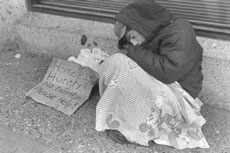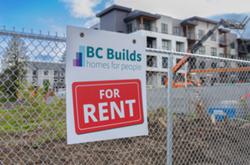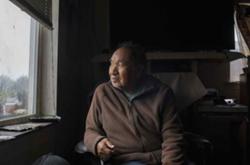
It was almost like Dave Nash was trying to prove Premier Gordon Campbell wrong. Nash, an affable Victoria activist, was a long-term welfare recipient who was expected to work. But he didn't leave welfare for a job. In October, 2003, Nash died at the age of 55.
Campbell and a succession of human resources ministers under him during the BC Liberals’ first mandate - Murray Coell, Stan Hagen and Susan Brice - have bragged that the rapidly shrinking welfare caseload is a result of a booming economy and people moving off welfare and into jobs.
But as it turns out, Nash wasn't the only person to leave the welfare rolls via the morgue.
The month he died, he was just one of 161 people who went out that way, according to documents obtained under the Freedom of Information Act. Between June 2002 and January 2005, a period of 32 months, 6,065 people on welfare died.
(To put that in perspective, in 2003, the latest for which statistics are available, 443 people reportedly died in traffic accidents in the province.)
For comparison, during that period, 37,404 people left welfare by Campbell's preferred route, because they obtained employment. Put another way, for roughly every six people on welfare who got a job, one died.
Reasons for welfare deaths not tracked
While the number of deaths may sound shockingly high, perhaps more surprising is that the ministry does not keep track of why people die while on welfare.
So what happened to those 6,065 welfare recipients who died? Did they freeze to death? Have heart attacks? Kill themselves? Starve? Nobody knows.
A health ministry spokesperson says, "It's not part of the vital statistics database . . . We track deaths but not people's income status associated with it." The vital statistics office does keep track of what people who have died did for a living, but there is nowhere in their documents to indicate whether a person was on welfare or receiving income assistance.
An official with the B.C. coroners service says it doesn't gather information about employment or income assistance in its record of death investigations
The minister for employment and income assistance, Claude Richmond, who has been in his post for less than three months, will be "out of town" until late August and not reachable for comment, says ministry spokesperson Richard Chambers.
One thing the ministry does keep a close eye on is the caseload statistics, which show the number of people in the province who are surviving on welfare each month. The ministry is behind schedule posting caseload statistics, but Chambers says that when they are updated they will show that in June, 2005, there were 145,079 people surviving on welfare. That's down by 1,419 from May, and by over 107,000 from when the Liberals took power in June, 2001. And more specifically, in four years, he says, the "expected to work" category for people who are required to look for a job has declined by 78 percent.
Turning off the tap
Despite claims that everyone is working, it has been unclear why the numbers are dropping. A government attempt to distribute "exit surveys" showing what people are doing six months after they leave welfare was abandoned after it was pointed out that the surveyors couldn't find the majority of the people for whom they were looking.
In a report on welfare-to-work programs commissioned by the province and released August 3, Victoria researchers Peter Adams and Cathy Tait state as fact "that the [B.C. Employment and Assistance] Expected to Work caseload has been declining sharply over the last two years because of changes in government policies with respect to eligibility and benefits."
Researchers like Seth Klein, the director of the BC office of the Canadian Centre for Policy Alternatives, have suspected for some time that changes the Liberals made to welfare eligibility requirements in June, 2002, are having the effect of shutting people out at the entrance. Or as Bruce Wallace, a researcher with the Vancouver Island Public Interest Research Group, says, when looking at whether the system as a whole is working, "Caseload decline is not necessarily a good measure. It doesn't necessarily mean people are moving into work . . . It's also because people are not able to get onto welfare."
Most people who collect welfare do so only for a short time, so there is a constant flow off the caseload. When the ministry tightens the eligibility requirements, as it did in 2002, it has the effect of closing a tap so that those who leave are not replaced.
‘No case made’
There are a variety of reasons why they are shut out. The ministry provided a table showing the number of times different codes for "no case made" were entered in the ministry's computer system between June 2002 and January 2005. They include having the wrong immigration status (13), not providing a social insurance number (23), not showing identification (10), living on an aboriginal reserve (18) and being in prison or a half-way house (22).
Four codes were entered for "client has disposed of available assets without due consideration." The code for "quit/fired/refused employment" came up 54 times. Fifty people were denied welfare because they were students in secondary or post-secondary school and 175 were out of luck because they were under 19 years old.
A number were also affected by employment requirements. In November, 2003, workers stopped using the code "non-compliance—job search", but before then it was used 111 times. In the same month they began using "fails to meet employment obligations", which had been entered just 20 times by January, 2005.
The first codes for not meeting the Liberals’ controversial independence test appear in October, 2002. In the following months it was entered 764 times. Under the rule, which is unique to BC, a person applying for welfare has to prove they have made $7,000 a year in the past two years. The independence code was used twice as often as the code for "income in excess", which came up 356 times, and more than three times as often as the code for "assets in excess", which came up 229 times.
Given what we know about the number of people who seek welfare, the total number of codes entered seems suspiciously low. In a given month, like January, 2005, for instance, just 30 "no case made" codes were entered. A note cautions that more than one code may be applied to each file: "the total number of files closed is always less than the total number of NCM codes used in any given month."
Do that few people really apply?
The explanation seems to lie in what is counted as an "application". In 2002, the Liberals introduced a three-week wait period between when people make a "pre-application" and when they go through the full application procedure. Clearly the wait period has had an effect. The ministry's Chambers explains that many people don't return after that period. "In some cases, files aren't even opened," he says.
In February, Monday Magazine reported that in each month since the Liberals changed the rules, over 3,000 British Columbians who filled out a pre-application form never received help. The ministry provided the numbers in response to a freedom of information request. Between June, 2002, and September, 2004, a total of 206,759 people filled out "pre-application" forms because they were seeking assistance. Over that same period a total of 122,361 people completed the application process and began receiving welfare payments.
In other words, 84,000 people, or about four out of 10, who filled out a pre-application form did not get help. Now it appears they didn't even complete the application process.
Asked about people who pre-apply then don't come back after three weeks, Chambers says, "If they don't come back it's because they no longer require income assistance. Their financial circumstances have changed." They may have found a job, he says, or moved back into a parent's home. "In any case they're in a different position . . . than they were when they first came in."
Opening the drain
Many of the codes that are used for denying people help are also applied to people who are already receiving welfare payments. And there are others, such as "person deceased" that only get applied to people already on the rolls. In all there are 44 different codes, and a note says that for each time a case is closed up to six codes may be entered.
EAWs entered the code for "no response to cheque hold or letter" a total of 50,850 times, many more than they entered a code saying someone got a job. Another 5,865 were for "cheque returned, no client contact." And yet another 18,267 were automatically closed by the ministry's computer system, which ministry spokesperson Chambers explains is usually because they've been asked to pick up a cheque at a welfare office and haven't come in.
The code for "moved out of province" got entered 6,325 times. A return to secondary or post-secondary school factored in the closing of 5,854 cases. A stay in prison or half-way house was involved in 1,955 closures. Other codes cover people having too much income, having too many assets, being under 19 years old, living on an aboriginal reserve or not being Canadian. The code for "Quit/Fired/Refused employment" got entered 651 times.
A total of 6,059 entries were made for "refused request for information."
"Sometimes they do quite a financial audit when you're applying," says Sue Hendricks, an income assistance advocate with Victoria's Together Against Poverty Society. It's normal for the workers to ask for an income tax return and bank statements, she says. Other times they want things that are more difficult to get, such as income tax returns going back three years, older bank statements, credit card receipts or banking information for the applicant's roommates.
For people with disabilities, she says, there is a 23-page booklet that needs to be filled out by a doctor. It requires a great deal of care, she adds. "It's very difficult to pass that one."
A few other numbers show how policies introduced by the B.C. Liberals in 2002 were used to cut people off. The code for "non-compliance—job search" got entered 2,097 times, but the last time was in November 2003. In that same month, ministry workers began entering the code for "non-compliant with employment plan." By January 2005, little more than a year later, they would have used it 2,723 times.
‘A very arbitrary rule’
Hendricks says many of the people she's seen since starting at TAPS in March have lost welfare payments because of not doing a job search or complying with an employment plan. There was one client, for instance, who was supposed to go to the John Howard Society for job training. "He missed only one appointment and he was cut off." A single mom with three kids, including a 21-year-old daughter with developmental challenges and two who were younger, faced a similar situation. She was in a job program for women with barriers to employment, but "She missed appointments because her daughter was sick . . . She just felt she needed to be there for this person, and she got cut off." Eventually the ministry put her back on, but not before causing a great deal of stress.
Hendricks also remembers a woman with two kids under six who was expected to work. "I had a woman who had children but she didn't have daycare but she had to go on a job search," she says. "She wanted to do a job search," she adds, but it didn't make sense to drag the children around to do it.
Finally, "does not meet 2-year independence test", which requires a person to show they've earned at least $7,000 a year in the previous two years, first came up as a reason for a case being closed in October 2002. It has since been used 2,812 times. "The people who are having trouble with it are of course young people. And immigrants," says Hendricks.
"It's a very arbitrary rule," says VIPIRG's Wallace, who has been researching why people are denied welfare. "The problem with the test is it's actually denying financial assistance to people who are in dire need . . . It disregards that person's emergency."
When Murray Coell was the human resources minister, he argued the rule is about breaking the cycle of welfare dependence and forcing people to become self-sufficient. Wallace says, "I don't think it really is an effective way to meet the ministry's goal of helping people find jobs." He thinks there's another agenda: "It's expressly made to deny young folks welfare."
And it has another effect, he says. "It also acts as a disincentive to apply. . . There are obviously many people who know they can't apply because they don't have two-year independence."
There's been a fair bit of publicity around the independence test, he says, but there has been little about the exemptions to it. Many don't know the test doesn't apply in a number of situations, including when they have been in jail for six months, are leaving an abusive relationship or are in emergency need. Even when a person applies for welfare, he says, the worker they deal with may or may not offer information about the exemptions.
The result, he says, is a system that does a poor job at what it's supposed to do, providing financial assistance to people who are in dire need.
Ministry spokesperson Richard Chambers sees it very differently: "The system of income assistance we have here is working and more resources are going to the people who need them most."
Welfare payments to rise?
There are stories circulating among welfare advocates that the ministry is going to raise the rates soon. There's no question that's necessary. As TAPS' Hendricks says, "No one can live on $510 a month in Victoria."
But to fix the system, to get it back to where it is a reliable safety net for people in need, the government has to do a lot more than raise the rates. Dropping the two-year independence test and stream-lining the bureaucratic application process would be a good place to start.
Andrew MacLeod is a frequent contributor to The Tyee and a staff writer for Monday Magazine in Victoria where a version of this article also runs today. His previous Tyee articles on welfare issues include:
Libs' Welfare-to-Jobs Program a Bust, Reveals Delayed Report Welfare's New Era: Survival of the Fittest
Where Did All the Welfare Cases Go?















Tyee Commenting Guidelines
Comments that violate guidelines risk being deleted, and violations may result in a temporary or permanent user ban. Maintain the spirit of good conversation to stay in the discussion.
*Please note The Tyee is not a forum for spreading misinformation about COVID-19, denying its existence or minimizing its risk to public health.
Do:
Do not: